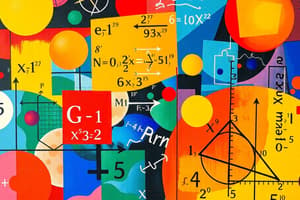Podcast
Questions and Answers
How does a number line help in understanding the order and magnitude of numbers?
How does a number line help in understanding the order and magnitude of numbers?
A number line visually represents the sequence of numbers, allowing for easy comparison of their values based on their position.
What role do equations and formulas play in mathematical problem-solving?
What role do equations and formulas play in mathematical problem-solving?
Equations and formulas represent relationships between variables, providing a structured approach to calculate unknown values.
Describe an effective problem-solving strategy that involves utilizing diagrams.
Describe an effective problem-solving strategy that involves utilizing diagrams.
Using diagrams helps to visualize the problem, making complex relationships and spatial configurations clearer.
Why is it important to check the answer after solving a mathematical problem?
Why is it important to check the answer after solving a mathematical problem?
How does mathematical notation improve clarity in mathematical communication?
How does mathematical notation improve clarity in mathematical communication?
How does algebra differ from arithmetic in terms of its approach to numbers?
How does algebra differ from arithmetic in terms of its approach to numbers?
What is the significance of the order of operations in mathematics?
What is the significance of the order of operations in mathematics?
Explain the relationship between geometry and trigonometry.
Explain the relationship between geometry and trigonometry.
In what ways do mathematical proofs contribute to the validity of mathematical theories?
In what ways do mathematical proofs contribute to the validity of mathematical theories?
What role does abstract thinking play in mathematical problem-solving?
What role does abstract thinking play in mathematical problem-solving?
Identify two applications of statistics in everyday life.
Identify two applications of statistics in everyday life.
How do the properties of numbers, such as commutativity, influence mathematical operations?
How do the properties of numbers, such as commutativity, influence mathematical operations?
Discuss how calculus applies to real-world scientific scenarios.
Discuss how calculus applies to real-world scientific scenarios.
Flashcards
What is a number line?
What is a number line?
A visual representation of numbers that helps understand their order and magnitude.
What are equations and formulas?
What are equations and formulas?
Statements of equality or relationships between variables used for calculations and problem solving.
What's the first step in problem solving?
What's the first step in problem solving?
Understanding what is known and what is unknown in a problem.
What are graphs used for?
What are graphs used for?
Signup and view all the flashcards
How do you develop a plan for problem solving?
How do you develop a plan for problem solving?
Signup and view all the flashcards
Arithmetic
Arithmetic
Signup and view all the flashcards
Algebra
Algebra
Signup and view all the flashcards
Geometry
Geometry
Signup and view all the flashcards
Order of Operations (PEMDAS/BODMAS)
Order of Operations (PEMDAS/BODMAS)
Signup and view all the flashcards
Properties of Numbers
Properties of Numbers
Signup and view all the flashcards
Number Systems
Number Systems
Signup and view all the flashcards
Logic and Reasoning
Logic and Reasoning
Signup and view all the flashcards
Abstract Thinking
Abstract Thinking
Signup and view all the flashcards
Study Notes
Fundamental Concepts
- Mathematics is a science that deals with numbers, quantity, and space.
- It encompasses various branches, including arithmetic, algebra, geometry, calculus, and more.
- Key concepts in mathematics often involve patterns, relationships, and logical reasoning.
- Mathematical theories are typically supported by rigorous proofs.
- Problem-solving is crucial to understanding mathematical concepts and applications.
Branches of Mathematics
- Arithmetic: Deals with the basic operations of numbers (addition, subtraction, multiplication, division) and their properties.
- Algebra: Uses letters (variables) to represent numbers and develops equations and methods to solve for unknowns. Focuses on relationships and patterns.
- Geometry: Studies shapes, sizes, and positions of figures in space. Includes concepts like points, lines, angles, triangles, and circles.
- Calculus: Deals with continuous change and motion. Includes differential and integral calculus, used in various scientific applications.
- Trigonometry: Studies relationships between angles and sides of triangles, and their applications in solving for unknown values.
Key Principles
- Order of operations (PEMDAS/BODMAS): A set of rules dictating the sequence of calculations in expressions involving multiple operations.
- Properties of numbers: Rules like commutativity, associativity, and distributivity governing operations on numbers.
- Number systems: Different sets of numbers (natural, whole, integers, rational, irrational, real, complex) with specific properties and relationships.
- Logic and reasoning: Essential for proving mathematical theorems and validating arguments through deductive and inductive reasoning.
- Abstract thinking: Employing abstract concepts such as sets, functions, and transformations to represent or solve problems.
Applications of Mathematics
- Science and Engineering: Critical in developing scientific models, predicting phenomena, and designing systems.
- Computer Science: Foundational for algorithms, data structures, cryptography, and artificial intelligence.
- Finance and Economics: Used for modeling markets, risk assessment, and investment strategies.
- Statistics and Probability: Tools for analyzing data, making informed decisions based on uncertain outcomes.
- Everyday life: Essential for tasks like budgeting, measuring, and problem-solving.
Mathematical Tools
- Number line: A visual representation of numbers that helps understand their order and magnitude.
- Graphs: Visual representations of relationships between variables, allowing for easier interpretation of data.
- Equations and formulas: Statements of equality or relationships between variables used for calculations and problem solving.
- Geometric figures and diagrams: Aid in understanding spatial relationships.
- Mathematical symbols: Used to concisely represent operations, variables, and concepts (e.g., +, -, ×, ÷, >, <, =, √, π, etc.).
Problem-Solving Strategies
- Identifying the problem: Understanding what is known and what is unknown.
- Developing a plan: Choosing an appropriate strategy (e.g., working backwards, using diagrams, using analogies).
- Carrying out the plan: Implementing the chosen strategy.
- Checking the answer: Validating the solution and ensuring it aligns with the problem.
- Communicating the solution: Effectively showing the steps and reasoning used.
Mathematical Notation
- Understanding symbols and notations (e.g., +, -, ×, ÷, >, <, =, √, π, etc.) is essential for interpreting and communicating mathematical information.
- Using correct notation helps maintain clarity and precision in mathematical discourse.
Sets
- A set is a well-defined collection of distinct objects.
- Sets are fundamental in mathematics for grouping and organizing elements.
Studying That Suits You
Use AI to generate personalized quizzes and flashcards to suit your learning preferences.




